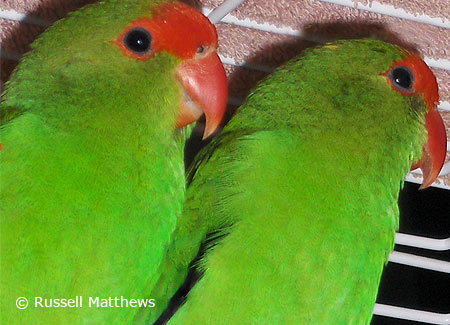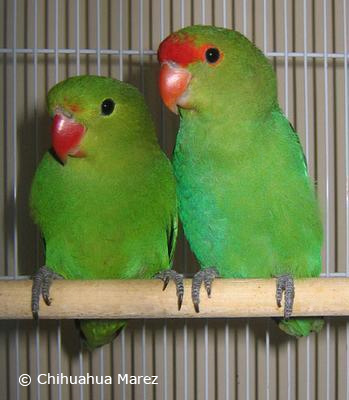Abyssinian Lovebird
Common Names:
Abby, Black Winged Lovebird
Scientific Name:
Agapornis taranta
Origin: Ethiopia,
Eritrea
Relative Size: 6 1/2
inches
Weight: 55-60 grams
Average Lifespan:
10-20 years
Egg Clutch: 2-4
white eggs
Incubation: 24 days
Talking Ability:
Poor

General Information about Abyssinian Lovebirds
Most lovebirds are bright and often look as if they
have been touched by the colors of a rainbow; however, Abyssinians are
quite the opposite. Their color is often simple but yet elegant. These
tiny parrots have dark green bodies and dark green wing covers. The
primary flight feathers are black, thus giving this parrot another
popular name - the Black Winged Lovebird. Their rump feathers are a
lighter green color with a black-tipped tail. Their beaks are red and
their feet are charcoal colored.
Unlike most lovebirds, these birds are sexually dimorphic. This simply
means that males and females can be easily told apart. Males have a
bright red forehead and a red ring that circles their eyes. Females lack
these markings but are just as attractive.
Young juvenile Abyssinians will have orange beaks when they first
fledge. After a few weeks the beaks change to their standard red color.
Only when the birds have reached eight to nine months will the juveniles
start to attain their adult plumage.
Abyssinian Lovebirds are large compared to other lovebirds. In fact,
they are the largest of the lovebird species. Most Abyssinians are about
six and half inches; however, they can vary somewhat.
Abyssinian Lovebirds in the Wild
This parrot is from Central and Eastern Ethiopia and Eritrea. Its
habitat consists of high grasslands intermixed with trees and shrubs.
Some Abyssinian Lovebirds will thrive in lower grasslands, but most
prefer highland environments. These parrots enjoy mild or cooler
temperatures and breed best in these conditions.
Abyssinian Lovebirds can be seen in large flocks around waterholes, but
are perfectly comfortable with other bird species when drinking water.
These birds are very cautious when on the ground, and they are
constantly scanning the area for danger. The slightest disturbance will
cause the parrot to fly away.
During the breeding season, a bonded pair will leave the group to raise
their young. The female will look for a cavity inside a tree, or for
holes within building walls to lay her eggs. These birds do not carry
nesting material back to their nests like most lovebirds. While the
female is incubating her eggs, the male will stand guard to alert of
incoming danger. The male also takes on the task of feeding the female
during this “nesting” time. The babies will fledge six weeks after
hatching.
Abyssinian Lovebirds In Captivity
Abyssinian Lovebirds are rarely found in captivity. These birds were
probably not kept due to a lack of mutations, their difficulty breeding,
and dietary requirements. Breeders who do work with them are quick to
point out the difficulty in housing these lovebirds.
The birds available in today’s market are mainly sold as breeders and
can be purchased at bird shows or from exclusive breeders. Many
aviculturists, who specialize in this particular parrot, continue to
document this species’ behavior, breeding habits, and diet. Many
breeders have devoted their lives to ensure these parrots remain in
aviculture and it is not uncommon for them to trade birds to strengthen
the bloodline.
These parrots make excellent pets; however, they are rare and really not
sold as pets. There is such a limited quantity of these parrots that
most are entered into breeding programs. Most breeders exchange their
lovebirds to keep the bloodline healthy and fresh.
Abyssinian Lovebirds as Pets
As a pet, an Abyssinian Lovebird can provide a rewarding experience.
They are very loyal and affectionate creatures. If handfed and properly
socialized, these parrots are very curious and will strongly bond to
their owners.
Like most lovebirds, females can become territorial; therefore, it is
important that an owner set consistent rules from day one. These
lovebirds have powerful beaks and can do more damage than a Peach Faced
Lovebird. Nibbling should not be encouraged, nor should any reactions
take place if the lovebird decides to bite. Abyssinians are more prone
to stress than Peach Faced, Masked, or Fischer’s Lovebirds. While
holding one of these lovebirds, an owner should never wobble their hand
or yell at the bird as this will only frighten it. This could lead to a
bird developing an aggressive behavior.
These parrots are very intelligent and inquisitive. They need a great
deal of toys to be stimulated mentally. All pet Abyssinians need
colorful wooden beads, ropes, and ladders to swing on.
They will gladly entertain their owners for head scratches and
affection. These comical parrots enjoy being carried around the house on
their owner’s shoulders and also enjoy being held when the owner is
relaxing.
Abyssinian Lovebirds can be loud and have a shrill call. They do not
make great talkers; however, they can learn to do tricks through
positive reinforcement.
Breeding Abyssinian Lovebirds

Ideal weather for breeding Abyssinians is late winter or early
spring, usually around April. These parrots do not breed well in warmer
weather, nor should it be practiced with any lovebird species. If
environment temperatures are too high, above 90 degrees Fahrenheit, the
babies and the mother will most likely be uncomfortable and this could
lead to death.
These parrots already have a reputation of being difficult to breed and
the owner should understand that it can take several years for a pair of
Abyssinians to breed successfully. Often times, these birds will lay
infertile eggs or the chicks will die during incubation.
When these lovebirds are paired up to breed, the owner should take extra
care to ensure these parrots have the proper privacy. Lovebirds caught
in the wild do not take kindly to nest inspections and will most likely
abandon their nests. First generation Abyssinians, who have been bred in
an aviary environment, are usually tolerant to humans and nests can be
examined.
It is important these birds have a layer of nesting material such as
wood shavings or dried grasses because these parrots do not collect
nesting material like most lovebirds. Once the female has secured a
nesting site, she will remove feathers from her chest to line the nest.
This is done to provide extra bedding for the babies. After modifying a
nest, the female will lay between two and four eggs. Eggs are produced
every other day until the clutch is complete. The duration of the
incubation is 24 days. The female will usually start to incubate after
the second egg is laid.
After the chicks hatch, the parents will feed the lovebirds around the
clock until the baby birds are ready to leave the nest. This occurs
between seven and eight weeks. At around ten weeks, all chicks should be
weaned.
Hand feeding and Fostering Baby Abyssinian Lovebirds
Should a baby Abyssinian lovebird need to be handfed, it is best to
use a higher fat formula made for macaws. These babies need more fat to
develop properly. Many babies that are fed a standard commercial
formula, tend to be smaller, may die, or can develop stress bars on
their feathers.
Should a baby need to be fostered, it is best that the baby be placed
with a pair of Fischer's Lovebirds. This causes the baby to grow much
slower. When the baby lovebird is around four weeks, the owner needs to
pull the baby for hand feeding as an Abyssinian Lovebird will be too
large for the Fischer's pair to continue feeding.
The Diet of the Abyssinian Lovebird
These parrots need more fat in their diet and higher levels of
Vitamin B to remain healthy. In the wild, these parrots feed on figs,
juniper berries, blossoms, and seeds. Many breeders will place these
foods inside the breeding cage a month before the breeding season. This
motivates the parrots to breed.
Unlike other lovebirds, Abyssinian Lovebirds are not picky eaters. Most
enjoy fresh greens like broccoli, spinach, kale, or carrot tops. Adding
tropical fruits to their diet such as papaya, mangos, apples, pears,
kiwi, or pomegranates make excellent sources of nutrients and provides
them with a tasty treat.
Providing the lovebirds with only a diet of pellets is not recommended.
They need a combination of seeds as well. Adding a sufficient amount of
sunflower and safflower seeds will supply the fat content they need in
order to thrive. When feeding your Abyssinian, it’s better to keep the
diet well balanced with seeds, pellets, fresh fruits, and fresh
vegetables.
If these parrots are routinely taken to the veterinarian, and fed a
healthy diet, most will live between 10 and 20 years.




